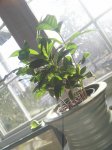Think about what type of image you want to create, and what can be done with your choice of species. A cluster of trunks, relatively slender trunks, not too tall, in a tray with wide area of moss around it, will look more like a distant grove on a hill. Implying the observer is far away. Larger diameter and taller trees, with trunks that are planted right up to the margins of the pot, suggest the observer is standing closer to the forest, or might even be in the forest. Also think about the age or type of forest you want to portray, gnarly trees with fat trunks, suggest an ancient forest. tall elegant trees, suggest a more middle aged forest, and thin but dense arrangement of younger trees would suggest a second growth type young forest. Think about what you want to create.
Coffee, because of the glossy leaves, myself would go for the distant young forest while young, each leaf representing a whole pad of foliage and branches seen from a distance. You can pretty much with a little imagination make these seedlings now work for this type of forest.
Or as the trunks pick up size, get closer to an inch in diameter, I would go for a close up feeling tall elegant forest. I do not think coffee will do gnarly very well. It is just not in the plant's habit. I could be wrong, but these are my thoughts. For this look, I would consider growing the seedlings out, in separate pots, One per pot, some grouped in twos or threes, the grouped trees very close together in a pot, until they were several feet tall, in order to thicken up the trunks. The idea being the grouped ones will fuse more quickly to be treated as a single root system. Then after a couple years, the trunks will have thickened up a bit, prune them back down to size and assemble the forest of the groups from the pots you grew out. This will give nice irregular spacing. Key to creating forests is to avoid them looking like rows of corn. Irregularity is key.
If you are trying to increase trunk diameter to create size and age illusions, you must keep the tree growing rapidly and in a significantly large pot, so the roots have room and the tree can actually grow. Once the root system is confined, the tree slows its growth and the increase in trunk diameter will be significantly slowed. I have a pomegranate, that started out as a 1/8th diameter, 12 inch tall cutting, it was always kept in as small a bonsai pot I could fit it into. A full 40 years later, a long time to be watering a tree, it was all of 1 inch in diameter and 12 inches tall. If I had used nursery pots, or large grow out containers, or put it in the ground it could have been 4 inches or even 6 inches in diameter, but it was only 1 inch in diameter, still looked too skinny for a 12 inch tall tree. Point of this paragraph, once the roots are confined, the increasing growth in the diameter of the trunk slows to almost no growth at all. Pruning roots and pruning the top of the tree will also significantly slow the growth rates. Trees in bonsai pots do not ''bulk up''. Put them back into nursery pots or out in the ground to get significant growth.
I have seen descriptions of how some of the Japanese masters create forests. They will use a group of trees that have already been grown as bonsai for 25 to 75 years, and mix together these trees of different ages to create their forest plantings. Most of us in the USA don't have the ability to commit that kind of time to preparing to put together a forest. I have a Dawn redwood forest in the making. Right now it is in 2 anderson flats (17 x 17 x 5 inch deep pots) 4 trees in one and 5 trees in the other. They were 5 year old, 24 inch tall whip seedlings the first time the forest was put together, then the forest was taken apart after 2 years, now in its second summer of ''growing out'' again. I may put it back together again this next spring, if I like the development of the branches.
Here's a thought, looks like you have 8 seedlings, take 7 and make your forest when you get your tray. Take the one and see how large you can get it to grow in a separate pot. Grow it out like you were going to make a single tree bonsai. See how rapidly you can get it growing & how quickly it can trunk up. Based on how it responds, decide how far you want to dive into the forest projects. You need to get a feel for how coffee grows, branches, and responds to wiring to help you decide what designs you can create with coffee.
Hope that helps.


